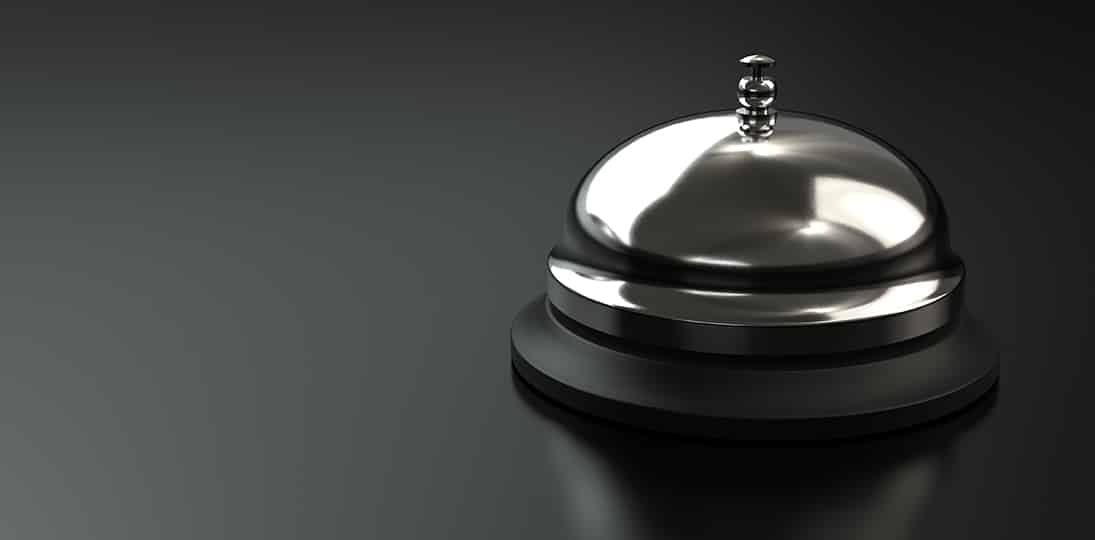People today are constantly interacting with devices to get the information they need and want. Combining hotel digital signage with kiosks and interactive touchscreens lets them sift through vast amounts of information, choosing what they like, without being overwhelmed. This strategy can also help free up your staff, giving them more time and energy to customizing the hotel guest experience. A lot of hotels thrive on loyalty to their brand, which comes from providing the best service possible. Digital signage allows you to increase the ways in which you provide that service.
Displays
First off, you’ll want some wall-mounted displays around the lobby and at high-traffic points like elevator banks. Display welcome messages, property info, guest services, exchange rates, even restaurant and café menus. Because it’s easy to insert a message into your playlist, you can also add short-term information, like current seminars or workshops for an in-house conference. And all of these messages can be scheduled to automatically drop off the playlist once they expire.
Think of all those paper brochures you had in stands around your hotel. You don’t need them anymore – everything that was there can now be up on the displays, able to be changed and updated instantly, saving a huge amount of cost and effort.
Someone standing in line to check-in will have already seen your messages and have an idea of what’s available for them by the time they get to the desk. This allows your staff more time to make the guests feel welcome, and speeds the check-in process. If someone has a question about something, staff can simply point out a nearby display, and the guest can see for themselves what’s available or happening on-site. For those guests that prefer a human touch, your staff will have more time to provide individualized service.
Touchscreens
Interactive touchscreens let you show all the messages non-interactive displays can, plus more. Directories can hold dense amounts of information, and the guests can choose what they need without feeling overwhelmed or having to wait through a long playlist rotation for what they need.
You can also provide extras, like local time and weather, news, stock market activity, fun facts and information about nearby points of interest. These screens can be on their own in the lobby, or part of a digital lounge where people can relax and browse through available options.
Wayfinding is must for interactive displays. User-friendly maps and directions make it a simple matter for guests to find their rooms, on-site facilities like the business center, salons and shopping, event registration, and so on. You can even incorporate a reservation system, so people can book a service right there at the display. And wayfinding can extend beyond the hotel itself, to include local attractions, transportation schedules, and even taxi services.
Kiosks
Kiosks are simply interactive touchscreen displays mounted in a pedestal of some sort for easy access, instead of on the wall. They can be placed literally anywhere you like. All the information the other types of displays can show, kiosks can also show. But they are even more flexible. You can put them in hallways and corridors, in lounges, in waiting areas, or anywhere people might use them.
In the lobby, they can also be used for fast and efficient check-in and check-out procedures. In hallways and corridors, they can be used to make reservations at the spa or restaurant without requiring the guest to go all the way downstairs and wait in line to talk to someone, or make a phone call to the front desk.
In bars and cafes, people can browse through your property info while having a relaxing drink and chatting with friends and colleagues. Menus on screen can let people not only see what’s on offer, but get detailed nutritional and allergy information, and let them place orders before being seated.
Kiosks are a great place to have people sign up for your loyalty programs, newsletters and other communications. They can even stand in as a concierge – theatre tickets, flower delivery, shopping – all these can be done through an interactive kiosk with a web connection.
This isn’t new technology – what is new is that people are very comfortable with getting information this way now. Think of a kiosk as a really big tablet. In fact, a kiosk could quite simply be a web-connected tablet device on a stand. Modern kiosks have lower emissions and use less power than larger displays, and can be tailored to meet ADA guidelines.
Interactive touchscreens and kiosks also allow you to track what people search for, giving you immediate ROI in addition to functionality. This allows you to regularly tweak things to improve the customer experience.
By using digital signage well, you can give your guests a modern, info-packed experience. Your displays, interactive screens and kiosks are available 24 hours a day, seven days a week. They never get tired, and never make a mistake. And your guests will never wonder what’s available to them or how to take the next step.
